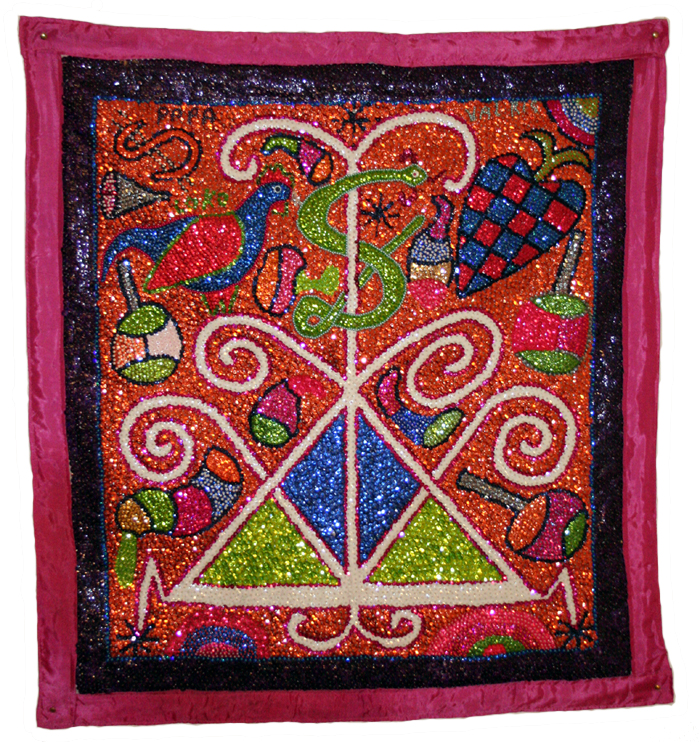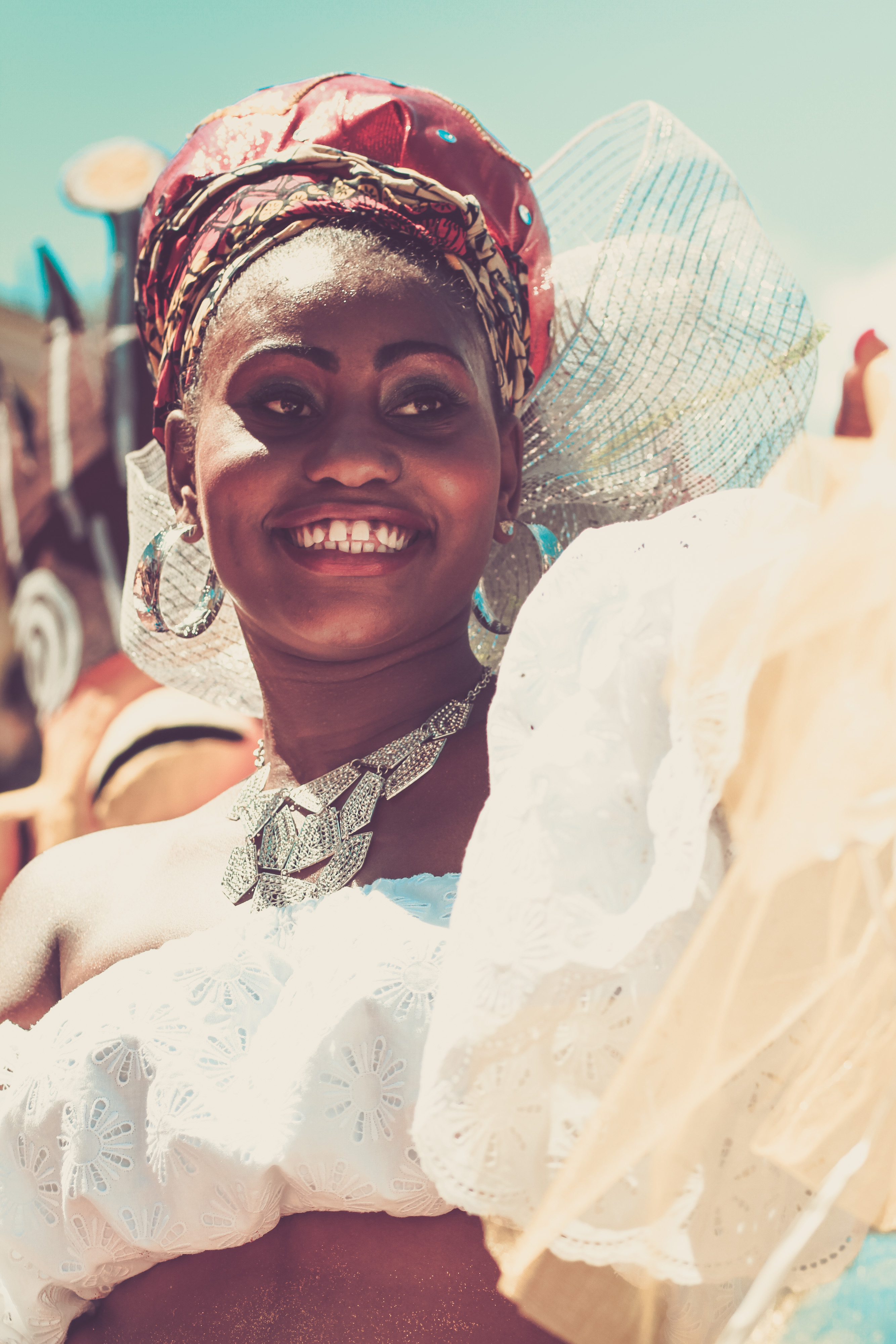|
Haitian Vodou
Haitian Vodou is an African diasporic religion that developed in Haiti between the 16th and 19th centuries. It arose through a process of syncretism between several traditional religions of West and Central Africa and Roman Catholicism. There is no central authority in control of the religion and much diversity exists among practitioners, who are known as Vodouists, Vodouisants, or Serviteurs. Vodou revolves around spirits known as ''lwa.'' Typically deriving their names and attributes from traditional West and Central African divinities, they are equated with Roman Catholic saints. The lwa divide up into different groups, the ''nanchon'' ("nations"), most notably the Rada and the Petwo. Various myths and stories are told about these lwa, which are regarded as subservient to a transcendent creator deity, Bondye. This theology has been labelled both monotheistic and polytheistic. An initiatory tradition, Vodouists usually meet to venerate the lwa in an ''ounfò'' (temple), ru ... [...More Info...] [...Related Items...] OR: [Wikipedia] [Google] [Baidu] |
Afro-Haitian
Afro-Haitians or Black Haitians are Haitians who trace their full or partial ancestry to Sub-Saharan Africa. They form the largest racial group in Haiti and together with other Afro-Caribbean groups, the largest racial group in the region. The majority of Afro-Haitians are descendants of enslaved Africans brought to the island by the Spanish Empire and the Kingdom of France to work on plantations. Since the Haitian Revolution, Afro-Haitians have been the largest racial group in the country, accounting for 85% of the population in the early 21st century. The remaining 15% of the population is made up of mixed persons (mixed African and European descent) and other minor groups (European, Arab, and Asian descent). Origins The African people of Haiti derived from various areas, spanning from Senegal to the Congo. Most of which were brought from West Africa, with a considerable number also brought from Central Africa. Some of these groups include those from the former Kongo k ... [...More Info...] [...Related Items...] OR: [Wikipedia] [Google] [Baidu] |
Haitian Americans
Haitian Americans (french: Haïtiens-Américains; ht, ayisyen ameriken) are a group of Americans of full or partial Haitian origin or descent. The largest proportion of Haitians in the United States live in Little Haiti to the South Florida area. In addition, they have settled in major Northeast cities such as New York City, Boston, Philadelphia, Baltimore and Washington, D.C. and in Chicago and Detroit in the Midwest. Most are immigrants or their descendants from the mid-late 20th-century migrations to the United States. Haitian Americans represent the largest group within the Haitian diaspora. In 2018 the US Census estimated that 1,084,055 people of full or partial Haitian descent lived in the United States. During the 1960s and 1970s many Haitians emigrated to the U.S. to escape the oppressive conditions during the dictatorships of François "Papa Doc" and his son Jean-Claude "Baby Doc" Duvalier. Political unrest, economic strains and natural disasters have supplied addi ... [...More Info...] [...Related Items...] OR: [Wikipedia] [Google] [Baidu] |
Négritude
''Négritude'' (from French "Nègre" and "-itude" to denote a condition that can be translated as "Blackness") is a framework of critique and literary theory, developed mainly by francophone intellectuals, writers, and politicians of the African diaspora during the 1930s, aimed at raising and cultivating "Black consciousness" across Africa and its diaspora. Négritude gathers writers such as sisters Paulette and Jeanne Nardal (known for having laid the theoretical basis of the movement), Martinican poet Aimé Césaire, Abdoulaye Sadji, Léopold Sédar Senghor (the first President of Senegal), and Léon Damas of French Guiana. ''Négritude'' intellectuals disavowed colonialism, racism and Eurocentrism. They promoted African culture within a framework of persistent Franco-African ties. The intellectuals employed Marxist political philosophy, in the Black radical tradition. The writers drew heavily on a surrealist literary style, and some say they were also influenced somewhat by th ... [...More Info...] [...Related Items...] OR: [Wikipedia] [Google] [Baidu] |
Candomblé
Candomblé () is an African diasporic religion that developed in Brazil during the 19th century. It arose through a process of syncretism between several of the traditional religions of West Africa, especially that of the Yoruba, and the Roman Catholic form of Christianity. There is no central authority in control of Candomblé, which is organised through autonomous groups. Candomblé involves the veneration of spirits known as ''orixás''. Deriving their names and attributes from traditional West African deities, they are equated with Roman Catholic saints. Various myths are told about these orixás, which are regarded as subservient to a transcendent creator deity, Oludumaré. Each individual is believed to have a tutelary orixá who has been connected to them since before birth and who informs their personality. An initiatory tradition, Candomblé's members usually meet in temples known as ''terreiros'' run by priests called ''babalorixás'' and priestesses called ''ialorix� ... [...More Info...] [...Related Items...] OR: [Wikipedia] [Google] [Baidu] |
Santería
Santería (), also known as Regla de Ocha, Regla Lucumí, or Lucumí, is an African diasporic religion that developed in Cuba during the late 19th century. It arose through a process of syncretism between the traditional Yoruba religion of West Africa, the Roman Catholic form of Christianity, and Spiritism. There is no central authority in control of Santería and much diversity exists among practitioners, who are known as ''creyentes'' ("believers"). Santería is polytheistic and revolves around deities called ''oricha''. Deriving their names and attributes from traditional Yoruba divinities, they are equated with Roman Catholic saints. Each human is believed to have a personal link to a particular oricha who influences their personality. Various myths are told about these oricha, who are regarded as subservient to Olodumare, a transcendent creator deity. Olodumare is believed to be the ultimate source of ''aché'', a supernatural force permeating the universe that can be m ... [...More Info...] [...Related Items...] OR: [Wikipedia] [Google] [Baidu] |
Haitian Revolution
The Haitian Revolution (french: révolution haïtienne ; ht, revolisyon ayisyen) was a successful insurrection by self-liberated slaves against French colonial rule in Saint-Domingue, now the sovereign state of Haiti. The revolt began on 22 August 1791, and ended in 1804 with the former colony's independence. It involved black, biracial, French, Spanish, British, and Polish participants—with the ex-slave Toussaint Louverture emerging as Haiti's most prominent general. The revolution was the only slave uprising that led to the founding of a state which was both free from slavery (though not from forced labour) and ruled by non-whites and former captives. It is now widely seen as a defining moment in the history of the Atlantic World. The revolution's effects on the institution of slavery were felt throughout the Americas. The end of French rule and the abolition of slavery in the former colony was followed by a successful defense of the freedoms the former slaves won a ... [...More Info...] [...Related Items...] OR: [Wikipedia] [Google] [Baidu] |
Freemasonry
Freemasonry or Masonry refers to fraternal organisations that trace their origins to the local guilds of stonemasons that, from the end of the 13th century, regulated the qualifications of stonemasons and their interaction with authorities and clients. Modern Freemasonry broadly consists of two main recognition groups: * Regular Freemasonry insists that a volume of scripture be open in a working lodge, that every member profess belief in a Supreme Being, that no women be admitted, and that the discussion of religion and politics be banned. * Continental Freemasonry consists of the jurisdictions that have removed some, or all, of these restrictions. The basic, local organisational unit of Freemasonry is the Lodge. These private Lodges are usually supervised at the regional level (usually coterminous with a state, province, or national border) by a Grand Lodge or Grand Orient. There is no international, worldwide Grand Lodge that supervises all of Freemasonry; each Grand Lo ... [...More Info...] [...Related Items...] OR: [Wikipedia] [Google] [Baidu] |
Saint-Domingue
Saint-Domingue () was a French colony in the western portion of the Caribbean island of Hispaniola, in the area of modern-day Haiti, from 1659 to 1804. The name derives from the Spanish main city in the island, Santo Domingo, which came to refer specifically to the Spanish-held Captaincy General of Santo Domingo, now the Dominican Republic. The borders between the two were fluid and changed over time until they were finally solidified in the Dominican War of Independence in 1844. The French had established themselves on the western portion of the islands of Hispaniola and Tortuga by 1659. In the Treaty of Ryswick of 1697, Spain formally recognized French control of Tortuga Island and the western third of the island of Hispaniola. In 1791, slaves and some Dominican Creoles took part in the Vodou ceremony Bois Caïman and planned the Haitian Revolution. The slave rebellion later allied with Republican French forces following the abolition of slavery in the colony in 1793, ... [...More Info...] [...Related Items...] OR: [Wikipedia] [Google] [Baidu] |
French Colonial Empire
The French colonial empire () comprised the overseas colonies, protectorates and mandate territories that came under French rule from the 16th century onward. A distinction is generally made between the "First French Colonial Empire", that existed until 1814, by which time most of it had been lost or sold, and the "Second French Colonial Empire", which began with the conquest of Algiers in 1830. At its apex between the two world wars, the second French colonial empire was the second-largest colonial empire in the world behind the British Empire. France began to establish colonies in North America, the Caribbean and India in the 17th century but lost most of its possessions following its defeat in the Seven Years' War. The North American possessions were lost to Britain and Spain but the latter returned Louisiana (New France) to France in 1800. The territory was then sold to the United States in 1803. France rebuilt a new empire mostly after 1850, concentrating chiefly in ... [...More Info...] [...Related Items...] OR: [Wikipedia] [Google] [Baidu] |
Hispaniola
Hispaniola (, also ; es, La Española; Latin and french: Hispaniola; ht, Ispayola; tnq, Ayiti or Quisqueya) is an island in the Caribbean that is part of the Greater Antilles. Hispaniola is the most populous island in the West Indies, and the region's second largest in area, after the island of Cuba. The island is divided into two separate nations: the Spanish-speaking Dominican Republic (48,445 km2, 18,705 sq mi) to the east and the French/Haitian Creole-speaking Haiti (27,750 km2, 10,710 sq mi) to the west. The only other divided island in the Caribbean is Saint Martin, which is shared between France ( Saint Martin) and the Netherlands (Sint Maarten). Hispaniola is the site of one of the first European settlements in the Americas, La Navidad (1492–1493), as well as the first proper town, La Isabela (1493–1500), and the first permanent settlement, the current capital of the Dominican Republic, Santo Domingo (est. 1498). These settlements were founded succe ... [...More Info...] [...Related Items...] OR: [Wikipedia] [Google] [Baidu] |
Kongo People
The Kongo people ( kg, Bisi Kongo, , singular: ; also , singular: ) are a Bantu ethnic group primarily defined as the speakers of Kikongo. Subgroups include the Beembe, Bwende, Vili, Sundi, Yombe, Dondo, Lari, and others. They have lived along the Atlantic coast of Central Africa, in a region that by the 15th century was a centralized and well-organized Kingdom of Kongo, but is now a part of three countries. Their highest concentrations are found south of in the Republic of the Congo, southwest of Pool Malebo and west of the Kwango River in the Democratic Republic of the Congo, north of Luanda, Angola and southwest Gabon. They are the largest ethnic group in the Republic of the Congo, and one of the major ethnic groups in the other two countries they are found in. In 1975, the Kongo population was reported as 4,040,000. The Kongo people were among the earliest indigenous Africans to welcome Portuguese traders in 1483 CE, and began converting to Catholicism in the l ... [...More Info...] [...Related Items...] OR: [Wikipedia] [Google] [Baidu] |






